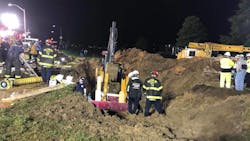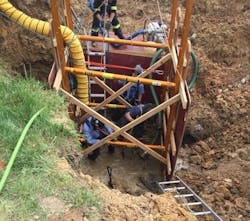Baltimore FFs Cite Lack of Shoring in Trench Death
June 07 -- Baltimore Fire Department officials said Wednesday that a deep trench that collapsed around a 19-year-old construction worker did not have protective shoring to stop the muddy earth from caving in.
The Maryland Occupational Safety and Health office is investigating the conditions that led to the death Tuesday of Kyle Hancock in the 2000 block of Sinclair Lane in the city’s Clifton Park neighborhood, agency spokeswoman Theresa Blaner said Wednesday. She declined to comment further. She said she would not speculate on what investigators might find.
Federal law establishes safety procedures for those working in trenches. According to the U.S. Occupational Safety and Health Administration, trenches 5 feet or deeper must have protective systems such as shored-up walls, shields and sloped ways out. Dozens of workers are killed each year in trench collapses across the country.
White Marsh-based R.F. Warder Inc. was the contractor on site to repair a backed-up sewer line from a nearby recreation center, city officials said. The company did not respond to requests for comment. According to its website, R.F. Warder was founded in 1990 and is locally owned.
The Fire Department’s Special Operations Command unit, called to the scene Tuesday afternoon, pulled two other construction workers out of the ditch and immediately put up a protective barrier. Rescue workers spent the next 10 hours using hand shovels and other equipment to carefully dig more than 20 feet down to recover Hancock’s body under massive piles of dirt and debris, department spokeswoman Blair Skinner said.
His body was recovered at about 1:30 a.m.
“Because we didn’t know the condition of the trench and in fear of a potential further collapse, firefighters immediately removed the two construction workers from the hole,” Skinner said. “We assessed the scene. We built what you call a protective barrier in order to send our members down in the hole to perform our recovery efforts. …
“When we arrived there was no shoring in place. Without that, the environment that they were in was not safe or conducive for them to even have gone in there to start digging.”
Skinner said fire officials are working closely with state investigators.
Hancock’s family was at the scene of the accident Tuesday night, Skinner said.
“This is really a sad and devastating time for the family and the members of the Special Operations Command Unit,” Skinner said. “They worked tirelessly, hours on end, to make sure they could recover the construction worker. It was completely devastating.”
Hancock was from Glen Burnie. Efforts to reach his family were unsuccessful.
The scope of the work being done on the sewer line is unclear. The city’s Department of Recreation and Parks did not provide information about the contract, including whether the work was for an emergency repair or scheduled improvements.
Skinner declined to comment on whether the rainy weather over recent weeks contributed to unsafe conditions for the excavation.
Skinner said construction workers at the scene directed rescue workers to the area where they believed Hancock was, allowing them to narrow their search. Hancock was inside the hole working on the sewage line when dirt and debris caved in on top of him.
Water, both from above above and below, posed a problem during the search. Rain poured around nightfall, forcing workers to pause. The sewer flowed into the trench.
“There was water accumulating at the bottom of the trench,” Skinner said.
Mayor Catherine E. Pugh said she met with Hancock’s family as rescue workers tried to locate him. By the time his body was found, the mayor said, most of the family had left because they didn’t want to see the final recovery. But his aunt and father remained.
“It was a long night,” Pugh said. “It was a very long night.”
The mayor thanked public works and fire department crews for their response.
“They worked tirelessly, tirelessly through the night,” Pugh said. “This was a reminder of the dedication of the people that work for us.”
Neighbors along Sinclair Lane watched as two large excavators overturned piles of dirt, expanding the trench into a massive hole where they hoped to find Hancock alive. A few onlookers expressed disbelief that the crew had dug such a deep trench without shoring it up.
Hancock’s co-workers were on the scene, assisting with recovery efforts where they could. They declined to speak with media.
Baltimore Sun reporters Tim Prudente, Lauren Lumpkin, Ian Duncan and Sarah Meehan contributed to this article.
___ (c)2018 The Baltimore Sun Visit The Baltimore Sun at www.baltimoresun.com Distributed by Tribune Content Agency, LLC.

